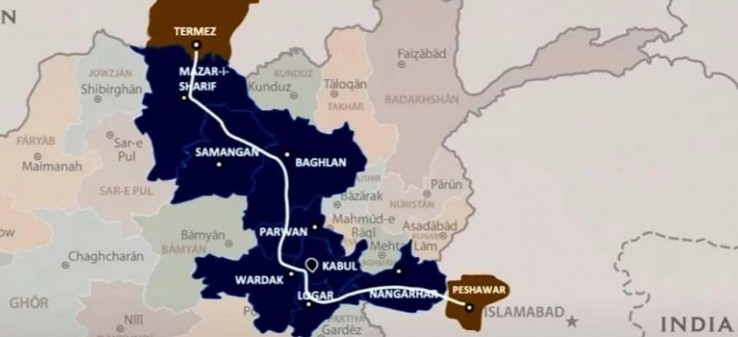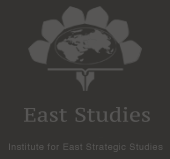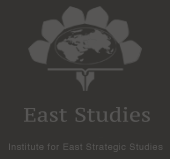Publish Date
Wednesday 20 August 2025 - 12:48
recommended
1
The Trans-Afghan Project
The Trans-Afghan Project; Opportunities and Challenges
The Trans-Afghan project is a railway line that begins from Termez, located on the southern border of Uzbekistan, and after crossing the Amu River enters Afghanistan. Within Afghanistan, two routes have been proposed for this project: The western route, known as the Kandahar Corridor, starts from Mazar-i-Sharif, heads toward Herat, and continues through Delaram and Kandahar before reaching Pakistan, where it connects to the Chaman border. The southern route, known as the Kabul Corridor, also begins from Mazar-i-Sharif, crosses through the Hindu Kush mountains via Logar Province near Kabul, extends to Paktia Province, and from there connects to the Kharlachi (dry) port in Pakistan. The length of this railway is estimated between 740 to 781 kilometers, making it the shortest route between Uzbekistan in Central Asia and Pakistan in South Asia.
By: Waliullah Moradian
15 Minutes Reading
15 Minutes Reading
Introduction
Recently in Kabul, an important trilateral memorandum of understanding (MoU) was signed among the governments of Uzbekistan, Pakistan and the Taliban. According to this MoU, feasibility studies of the Trans-Afghan railway project were signed among the Afghanistan’s Ministry of Public Works, Uzbekistan’s Ministry of Transport, and Pakistan’s Ministry of Railways, in the presence of the foreign ministers of the Taliban, Uzbekistan, and Pakistan.
The initial idea of the Trans-Afghan project was proposed in 2018 during the government of Ashraf Ghani in Afghanistan. However, due to the intensification of conflicts in Afghanistan, the project was halted. With the Taliban’s takeover in 2021, the project was once again put on the agenda.
Over the past few years, multiple negotiations were held between the Taliban, Uzbekistan, and Pakistan regarding this project, and ultimately, the three countries formally agreed to carry out its feasibility studies. By signing this agreement, the most crucial step toward implementation was taken, demonstrating the strong determination of all three countries to implement this project. What the Trans-Afghan project entails, and the opportunities and challenges it faces, are the central issues analyzed in this article.
Technical Specifications of the Trans-Afghan Project
The Trans-Afghan railway line begins from Termez on Uzbekistan’s southern border, crosses the Amu River, and enters Afghanistan. Inside Afghanistan, two routes are proposed:
The western route, known as Kandahar Corridor, starts from Mazar-i-Sharif, heads toward Herat, then goes to Pakistan via Delaram and Kandahar, and connects to Pakistan at the Chaman border.
The southern route, known as Kabul Corridor, begins from Mazar-i-Sharif, traverses the Hindu Kush mountains through Logar Province near Kabul, extends to Paktia Province, and from there connects to the Kharlachi dry port in Pakistan. The railway length is estimated at 740–781 km, representing the shortest distance between Uzbekistan in Central Asia and Pakistan in South Asia.
Based on preliminary data, the construction cost is estimated at around $7 billion, with a projected completion time of about five years. Once operational, it will reduce cargo delivery time between origin and destination to three to five days, while cutting container transport costs by two-thirds. Although no details have been disclosed regarding the costs and budget of feasibility studies, it is said that the feasibility work has been contracted to a joint Emirati-Uzbek company named ADL-ULANISH.
Regional Position and Economic Opportunities of the Trans-Afghan Project
• Economic Opportunities for the Three Countries
Above all, the economic benefits of the Trans-Afghan project are most prominent for Afghanistan, Uzbekistan, and Pakistan. For Afghanistan, the project offers vast economic advantages.
This mega-project, which in terms of construction is even larger and broader than the TAPI project, can in its first stage generate diverse employment and income opportunities for Afghans, considering its cost and construction period.
Spending $7 billion over at least five years will directly and indirectly create thousands of jobs for Afghans in the eight provinces the project traverses. Beyond employment in construction, the transfer of technical know-how related to railway building is also of high importance.
Afghanistan, having no significant railway infrastructure, lacks expertise in this field. Thus, the Trans-Afghan project could serve as a foundation for transferring this technical knowledge into Afghanistan and mark the beginning of expanding this vital infrastructure in the country. Once completed, the real profitability of the project for Afghanistan will begin. Initial estimates suggest that around 20 million tons of goods will be transported annually through this route, earning Afghanistan millions of dollars annually in transit fees.
Moreover, due to the reduction in the cost of moving goods from the north to the center and south of Afghanistan —down to two-thirds of previous expenses—as well as shorter delivery times, basic goods will become available to domestic consumers more quickly and at lower prices.
Additionally, considering the high wear and difficult conditions of road routes such as the Salang Highway —which is almost unusable for a quarter of the year—, shifting to a rail system will reduce reliance on roads, and saving significant financial costs for highway repairs, fuel consumption, and damages from road accidents.
For Uzbekistan and Pakistan, the Trans-Afghan project could mark a revolution in land connectivity. Both countries have extensive mutual economic needs, but the lack of a reliable route has hindered full utilization of bilateral capacities and opportunities. Implementation of the Trans-Afghan railway, as a secure, fast, and cost-effective land route, can open both countries’ markets widely to each other.
• Regional Position of the Trans-Afghan Project
Although, at first glance, the Trans-Afghan railway seems to be merely a trilateral connection, a broader view reveals its regional importance and significant trans-regional potential. If realized, not only will Uzbekistan, Afghanistan, and Pakistan be connected, but the project will also link the entire northern and southern parts of Asia.
In the northern part of this plan, six countries, aside from Russia, are located; and in the south lie two countries of the Indian subcontinent. Altogether, the project connects nine countries, covering millions of square kilometers and nearly two billion people. This enormous scale demonstrates that the Trans-Afghan railway is not merely a trilateral initiative, but a project with immense regional and global economic prospects.
Indeed, this project could be the starting point for other major regional corridors, and its successful execution would pave the way for additional transport routes. For instance, the Trans-Afghan line could serve as an extension of the “Belarus–Russia–Kazakhstan–Uzbekistan” international transport corridor. While this is a southern route, its completion within Afghanistan could also boost development of the Khaf–Herat railway. Consequently, China and Iran—situated east and west of Afghanistan—could integrate the Trans-Afghan route into a crossroad system for their transport ambitions.
Moreover, the Trans-Afghan railway is not only an economic necessity for the beneficiary countries, making its implementation almost inevitable, but also optimism for its realization is further reinforced by the interest shown by major regional powers such as Russia, China, and Kazakhstan. Even India and Pakistan, despite being locked in conflict, view this project as an economic matter beyond their disputes. In general, the reactions and interest expressed by surrounding countries indicate that shared economic needs, as well as the interdependence of other regional transit projects on the Trans-Afghan line, have fostered a spirit of cooperation rather than competition in this case.
Russia is optimistic that through the Trans-Afghan railway, it could link its entire rail network via Central Asia to South Asia, thereby alleviating part of its maritime transit constraints. China could incorporate the Trans-Afghan project into its Belt and Road Initiative (BRI), thereby diversifying its access to South Asia through Central Asia.
Although some attempt to portray the Trans-Afghan project as a rival to the Khaf–Herat line, these two projects are not competitors but rather complementary. The integration of the Khaf–Herat line with the Trans-Afghan railway would form a four-way complementary network. In this sense, for Iran too, the Trans-Afghan project represents an opportunity to connect with eastern and northern Asia.
For Kazakhstan and Kyrgyzstan, the project provides a golden opportunity to link to the south. For India, while its conflict with Pakistan persists, the Trans-Afghan line could become an avenue where economic benefits take precedence over rivalry and disputes. As previously mentioned, for Uzbekistan, Afghanistan, and Pakistan, the vital significance of this project is self-evident and undeniable.
Challenges Facing the Trans-Afghan Railway
Although the Trans-Afghan railway project is a large-scale initiative with enormous regional economic potential and there is a great interest across the region in its implementation, it faces obstacles and challenges that, if not entirely preventing its realization, will at least slow it down or postpone it. The most significant challenges fall into three categories: technical and financial, political-security, and competitive.
Although with today’s technological advances in infrastructure development, geographical complexities and natural barriers cannot be considered insurmountable, Afghanistan’s mountainous and challenging terrain could significantly increase construction costs. It is evident that bearing such a heavy financial burden exceeds the capacity of the three primary members of the project, making it necessary to seek other sources of funding.
Even though countries such as Qatar have expressed readiness to contribute part of the cost—and perhaps in the future other investors may also declare their willingness to join—meeting the initially estimated cost of about $7 billion remains a huge, high-risk commitment. One cannot simply expect such a large sum to be easily mobilized, especially given that this investment would be made in a country like Afghanistan, where, considering the unstable political and fragile security conditions, the risk of loss is very high. It is here that Afghanistan’s unstable political situation and insecure environment manifest themselves as major obstacles and challenges.
Although the Taliban have managed to establish relative security in Afghanistan and are on the path toward gaining formal recognition—beginning with Russia—this reality cannot be ignored that Afghanistan still contains numerous destabilizing dynamics. Beyond the presence of the Islamic State Khorasan Province (ISKP) in the country, which occasionally asserts itself through suicide and bomb attacks, the existence of political and paramilitary fronts lying in wait further undermines a favorable security outlook for Afghanistan.
Politically, too, the Taliban government lacks legal foundations, and this creates two major problems. First, without a people-based legal foundation, the Taliban government is prone to instability. Second, the absence of legal bases renders international contractual commitments ambiguous under international law. Even if, with the Taliban’s eventual recognition, some of these international legal problems are reduced in the coming years, the existence of multiple potentially hostile groups opposed to the Taliban makes it difficult to expect the kind of stability in Afghanistan required for the implementation of a project as large as the Trans-Afghan railway.
Another challenge facing the Trans-Afghan project—one deeply embedded within Afghanistan’s broader dynamics—is the negative competition of powers involved in the country. Since the primary beneficiaries of this project are the surrounding powers, and since their collective participation could also demonstrate a type of convergence among Asian powers, such a development would be very difficult for Western powers—particularly the United States—to tolerate. Consequently, the likelihood of obstruction and sabotage by Western actors in this project is quite high. It would be enough, for instance, for the United States to pressure funding sources such as Qatar (if it is one of them) or certain international banks to withdraw their commitments—in that case, the project would be prevented from moving forward.
Conclusion and the Future Outlook
Throughout its history, Afghanistan has consistently played a negative role in connecting the surrounding regions. The impact of this role has not only deprived Afghanistan itself of economic development but has also denied others the transit advantages of the country. Against this backdrop, can the Trans-Afghan project turn a new page in Afghanistan’s history and convert this negative role into a positive one?
This study showed that there are both hopes and concerns surrounding the project. On the one hand, its implementation could spark a transit revolution in regional transportation and, in the most optimistic scenario, integrate vast parts of the Asian continent into a unified network. On the other hand, the existence of mutual interests among Afghanistan’s neighboring countries— which provide specific benefits and advantages for each —creates further optimism for its realization.
Nevertheless, there are also factors that could slow down the project or even prevent its execution altogether. Chief among these challenges is the uncertainty regarding permanent stability in Afghanistan, which remains a highly concerning issue. Among external factors, the rivalry of great powers, given Afghanistan’s geopolitical realities, could hinder or even completely derail the project. Despite all these considerations, with the signing of the recent agreement, the Trans-Afghan project may represent a glimmer of hope that Afghanistan could move from playing a negative role to assuming a positive one in connecting its surrounding regions.
Ultimately, the ball is now in Afghanistan's court and in the hands of the Taliban government. While the Taliban have so far acted relatively well in the realm of foreign policy and taken appropriate measures, Afghanistan’s history shows that unless the internal drivers of conflict and strife are resolved, no firm assurances can be given regarding lasting stability in the country. Consequently, one cannot be fully confident about the implementation of mega-projects such as the Trans-Afghan railway either—since attracting investments into any country is fundamentally and deeply tied to its internal stability.
Waliullah Moradian is an Expert on Afghan Affairs.
Recently in Kabul, an important trilateral memorandum of understanding (MoU) was signed among the governments of Uzbekistan, Pakistan and the Taliban. According to this MoU, feasibility studies of the Trans-Afghan railway project were signed among the Afghanistan’s Ministry of Public Works, Uzbekistan’s Ministry of Transport, and Pakistan’s Ministry of Railways, in the presence of the foreign ministers of the Taliban, Uzbekistan, and Pakistan.
The initial idea of the Trans-Afghan project was proposed in 2018 during the government of Ashraf Ghani in Afghanistan. However, due to the intensification of conflicts in Afghanistan, the project was halted. With the Taliban’s takeover in 2021, the project was once again put on the agenda.
Over the past few years, multiple negotiations were held between the Taliban, Uzbekistan, and Pakistan regarding this project, and ultimately, the three countries formally agreed to carry out its feasibility studies. By signing this agreement, the most crucial step toward implementation was taken, demonstrating the strong determination of all three countries to implement this project. What the Trans-Afghan project entails, and the opportunities and challenges it faces, are the central issues analyzed in this article.
Technical Specifications of the Trans-Afghan Project
The Trans-Afghan railway line begins from Termez on Uzbekistan’s southern border, crosses the Amu River, and enters Afghanistan. Inside Afghanistan, two routes are proposed:
The western route, known as Kandahar Corridor, starts from Mazar-i-Sharif, heads toward Herat, then goes to Pakistan via Delaram and Kandahar, and connects to Pakistan at the Chaman border.
The southern route, known as Kabul Corridor, begins from Mazar-i-Sharif, traverses the Hindu Kush mountains through Logar Province near Kabul, extends to Paktia Province, and from there connects to the Kharlachi dry port in Pakistan. The railway length is estimated at 740–781 km, representing the shortest distance between Uzbekistan in Central Asia and Pakistan in South Asia.
Based on preliminary data, the construction cost is estimated at around $7 billion, with a projected completion time of about five years. Once operational, it will reduce cargo delivery time between origin and destination to three to five days, while cutting container transport costs by two-thirds. Although no details have been disclosed regarding the costs and budget of feasibility studies, it is said that the feasibility work has been contracted to a joint Emirati-Uzbek company named ADL-ULANISH.
Regional Position and Economic Opportunities of the Trans-Afghan Project
• Economic Opportunities for the Three Countries
Above all, the economic benefits of the Trans-Afghan project are most prominent for Afghanistan, Uzbekistan, and Pakistan. For Afghanistan, the project offers vast economic advantages.
This mega-project, which in terms of construction is even larger and broader than the TAPI project, can in its first stage generate diverse employment and income opportunities for Afghans, considering its cost and construction period.
Spending $7 billion over at least five years will directly and indirectly create thousands of jobs for Afghans in the eight provinces the project traverses. Beyond employment in construction, the transfer of technical know-how related to railway building is also of high importance.
Afghanistan, having no significant railway infrastructure, lacks expertise in this field. Thus, the Trans-Afghan project could serve as a foundation for transferring this technical knowledge into Afghanistan and mark the beginning of expanding this vital infrastructure in the country. Once completed, the real profitability of the project for Afghanistan will begin. Initial estimates suggest that around 20 million tons of goods will be transported annually through this route, earning Afghanistan millions of dollars annually in transit fees.
Moreover, due to the reduction in the cost of moving goods from the north to the center and south of Afghanistan —down to two-thirds of previous expenses—as well as shorter delivery times, basic goods will become available to domestic consumers more quickly and at lower prices.
Additionally, considering the high wear and difficult conditions of road routes such as the Salang Highway —which is almost unusable for a quarter of the year—, shifting to a rail system will reduce reliance on roads, and saving significant financial costs for highway repairs, fuel consumption, and damages from road accidents.
For Uzbekistan and Pakistan, the Trans-Afghan project could mark a revolution in land connectivity. Both countries have extensive mutual economic needs, but the lack of a reliable route has hindered full utilization of bilateral capacities and opportunities. Implementation of the Trans-Afghan railway, as a secure, fast, and cost-effective land route, can open both countries’ markets widely to each other.
• Regional Position of the Trans-Afghan Project
Although, at first glance, the Trans-Afghan railway seems to be merely a trilateral connection, a broader view reveals its regional importance and significant trans-regional potential. If realized, not only will Uzbekistan, Afghanistan, and Pakistan be connected, but the project will also link the entire northern and southern parts of Asia.
In the northern part of this plan, six countries, aside from Russia, are located; and in the south lie two countries of the Indian subcontinent. Altogether, the project connects nine countries, covering millions of square kilometers and nearly two billion people. This enormous scale demonstrates that the Trans-Afghan railway is not merely a trilateral initiative, but a project with immense regional and global economic prospects.
Indeed, this project could be the starting point for other major regional corridors, and its successful execution would pave the way for additional transport routes. For instance, the Trans-Afghan line could serve as an extension of the “Belarus–Russia–Kazakhstan–Uzbekistan” international transport corridor. While this is a southern route, its completion within Afghanistan could also boost development of the Khaf–Herat railway. Consequently, China and Iran—situated east and west of Afghanistan—could integrate the Trans-Afghan route into a crossroad system for their transport ambitions.
Moreover, the Trans-Afghan railway is not only an economic necessity for the beneficiary countries, making its implementation almost inevitable, but also optimism for its realization is further reinforced by the interest shown by major regional powers such as Russia, China, and Kazakhstan. Even India and Pakistan, despite being locked in conflict, view this project as an economic matter beyond their disputes. In general, the reactions and interest expressed by surrounding countries indicate that shared economic needs, as well as the interdependence of other regional transit projects on the Trans-Afghan line, have fostered a spirit of cooperation rather than competition in this case.
Russia is optimistic that through the Trans-Afghan railway, it could link its entire rail network via Central Asia to South Asia, thereby alleviating part of its maritime transit constraints. China could incorporate the Trans-Afghan project into its Belt and Road Initiative (BRI), thereby diversifying its access to South Asia through Central Asia.
Although some attempt to portray the Trans-Afghan project as a rival to the Khaf–Herat line, these two projects are not competitors but rather complementary. The integration of the Khaf–Herat line with the Trans-Afghan railway would form a four-way complementary network. In this sense, for Iran too, the Trans-Afghan project represents an opportunity to connect with eastern and northern Asia.
For Kazakhstan and Kyrgyzstan, the project provides a golden opportunity to link to the south. For India, while its conflict with Pakistan persists, the Trans-Afghan line could become an avenue where economic benefits take precedence over rivalry and disputes. As previously mentioned, for Uzbekistan, Afghanistan, and Pakistan, the vital significance of this project is self-evident and undeniable.
Challenges Facing the Trans-Afghan Railway
Although the Trans-Afghan railway project is a large-scale initiative with enormous regional economic potential and there is a great interest across the region in its implementation, it faces obstacles and challenges that, if not entirely preventing its realization, will at least slow it down or postpone it. The most significant challenges fall into three categories: technical and financial, political-security, and competitive.
Although with today’s technological advances in infrastructure development, geographical complexities and natural barriers cannot be considered insurmountable, Afghanistan’s mountainous and challenging terrain could significantly increase construction costs. It is evident that bearing such a heavy financial burden exceeds the capacity of the three primary members of the project, making it necessary to seek other sources of funding.
Even though countries such as Qatar have expressed readiness to contribute part of the cost—and perhaps in the future other investors may also declare their willingness to join—meeting the initially estimated cost of about $7 billion remains a huge, high-risk commitment. One cannot simply expect such a large sum to be easily mobilized, especially given that this investment would be made in a country like Afghanistan, where, considering the unstable political and fragile security conditions, the risk of loss is very high. It is here that Afghanistan’s unstable political situation and insecure environment manifest themselves as major obstacles and challenges.
Although the Taliban have managed to establish relative security in Afghanistan and are on the path toward gaining formal recognition—beginning with Russia—this reality cannot be ignored that Afghanistan still contains numerous destabilizing dynamics. Beyond the presence of the Islamic State Khorasan Province (ISKP) in the country, which occasionally asserts itself through suicide and bomb attacks, the existence of political and paramilitary fronts lying in wait further undermines a favorable security outlook for Afghanistan.
Politically, too, the Taliban government lacks legal foundations, and this creates two major problems. First, without a people-based legal foundation, the Taliban government is prone to instability. Second, the absence of legal bases renders international contractual commitments ambiguous under international law. Even if, with the Taliban’s eventual recognition, some of these international legal problems are reduced in the coming years, the existence of multiple potentially hostile groups opposed to the Taliban makes it difficult to expect the kind of stability in Afghanistan required for the implementation of a project as large as the Trans-Afghan railway.
Another challenge facing the Trans-Afghan project—one deeply embedded within Afghanistan’s broader dynamics—is the negative competition of powers involved in the country. Since the primary beneficiaries of this project are the surrounding powers, and since their collective participation could also demonstrate a type of convergence among Asian powers, such a development would be very difficult for Western powers—particularly the United States—to tolerate. Consequently, the likelihood of obstruction and sabotage by Western actors in this project is quite high. It would be enough, for instance, for the United States to pressure funding sources such as Qatar (if it is one of them) or certain international banks to withdraw their commitments—in that case, the project would be prevented from moving forward.
Conclusion and the Future Outlook
Throughout its history, Afghanistan has consistently played a negative role in connecting the surrounding regions. The impact of this role has not only deprived Afghanistan itself of economic development but has also denied others the transit advantages of the country. Against this backdrop, can the Trans-Afghan project turn a new page in Afghanistan’s history and convert this negative role into a positive one?
This study showed that there are both hopes and concerns surrounding the project. On the one hand, its implementation could spark a transit revolution in regional transportation and, in the most optimistic scenario, integrate vast parts of the Asian continent into a unified network. On the other hand, the existence of mutual interests among Afghanistan’s neighboring countries— which provide specific benefits and advantages for each —creates further optimism for its realization.
Nevertheless, there are also factors that could slow down the project or even prevent its execution altogether. Chief among these challenges is the uncertainty regarding permanent stability in Afghanistan, which remains a highly concerning issue. Among external factors, the rivalry of great powers, given Afghanistan’s geopolitical realities, could hinder or even completely derail the project. Despite all these considerations, with the signing of the recent agreement, the Trans-Afghan project may represent a glimmer of hope that Afghanistan could move from playing a negative role to assuming a positive one in connecting its surrounding regions.
Ultimately, the ball is now in Afghanistan's court and in the hands of the Taliban government. While the Taliban have so far acted relatively well in the realm of foreign policy and taken appropriate measures, Afghanistan’s history shows that unless the internal drivers of conflict and strife are resolved, no firm assurances can be given regarding lasting stability in the country. Consequently, one cannot be fully confident about the implementation of mega-projects such as the Trans-Afghan railway either—since attracting investments into any country is fundamentally and deeply tied to its internal stability.
News code:4086















